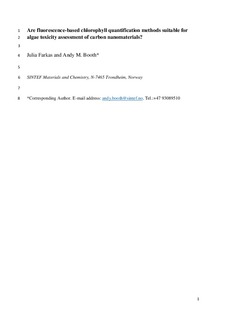| dc.contributor.author | Farkas, Julia | |
| dc.contributor.author | Booth, Andy | |
| dc.date.accessioned | 2017-11-20T20:09:09Z | |
| dc.date.available | 2017-11-20T20:09:09Z | |
| dc.date.created | 2017-05-11T09:23:46Z | |
| dc.date.issued | 2017-02-24 | |
| dc.identifier.citation | Nanotoxicology. 2017, 11 (4), 569-577. | nb_NO |
| dc.identifier.issn | 1743-5390 | |
| dc.identifier.uri | http://hdl.handle.net/11250/2467231 | |
| dc.description.abstract | Using a multi-walled carbon nanotube (MWCNT) and graphene oxide (GO) as representative test materials, we evaluated the applicability of in vivo and in vitro chlorophyll-a (Chl-a) fluorescence quantification methods, which are used in standard algae ecotoxicity tests such as OECD 201 and ISO 8692. In vivo quantification of Chl-a from Raphidocelis subcapitata indicated a significant reduction in Chl-a fluorescence in the presence of MWCNTs due to shading, but a significant autofluorescence from GO that caused an overestimation of Chl-a concentration. In vitro Chl-a quantification methods employing a modified acetone and an ethanol extraction protocol reduced the influence of shading and autofluorescence, but both resulted in a significant loss of fluorescence signal in the presence of 100 mg L−1 MWCNTS (99-100%) and GO (21-52%). Chl-a reduction was dose dependent for both tested CNM materials, but effects were more pronounced for MWCNT, which caused a significant fluorescence reduction (16±0.3%) already at 1 mg L−1. Further study of the CNM-algae-Chl-a interaction processes revealed that CNM can not only interact with live algae, but also efficiently adsorb extracted Chl-a. Our results showed that within 10 min, 95-100% of Chl-a extracted from two algae concentrations were adsorbed to MWCNT, while 35-60% of Chl-a was adsorbed to the GO. This study shows that Chl-a quantification by fluorescence determination is not a suitable method for ecotoxicity testing of CNM. However, a quick screening test for individual MNMs is recommended to determine if Chl-a adsorption is a significant process prior to selection of a quantification method. | nb_NO |
| dc.description.sponsorship | Polish-Norwegian Research Programme operated by the National Centre for Research and Development under the Norwegian Financial Mechanism 2009?2014 in the frame of Project Contract No Pol-Nor/237761/98/2014. | nb_NO |
| dc.language.iso | eng | nb_NO |
| dc.rights | Navngivelse-Ikkekommersiell-DelPåSammeVilkår 4.0 Internasjonal | * |
| dc.rights.uri | http://creativecommons.org/licenses/by-nc-sa/4.0/deed.no | * |
| dc.subject | Standard tests | nb_NO |
| dc.subject | adsorption | nb_NO |
| dc.subject | carbon nanotubes | nb_NO |
| dc.subject | graphene oxide | nb_NO |
| dc.title | Are fluorescence-based chlorophyll quantification methods suitable for algae toxicity assessment of carbon nanomaterials? | nb_NO |
| dc.type | Journal article | nb_NO |
| dc.type | Peer reviewed | nb_NO |
| dc.description.version | acceptedVersion | nb_NO |
| dc.rights.holder | the authors | nb_NO |
| dc.source.pagenumber | 569-577 | nb_NO |
| dc.source.volume | 11 | nb_NO |
| dc.source.journal | Nanotoxicology | nb_NO |
| dc.source.issue | 4 | nb_NO |
| dc.identifier.doi | 10.1080/17435390.2017.1329953 | |
| dc.identifier.cristin | 1469511 | |
| dc.relation.project | Norges forskningsråd: 239199 | nb_NO |
| dc.relation.project | EC/FP7/310584 | nb_NO |
| dc.relation.project | Norges forskningsråd: 237761 | nb_NO |
| cristin.unitcode | 7566,6,0,0 | |
| cristin.unitname | Miljøteknologi | |
| cristin.ispublished | true | |
| cristin.fulltext | postprint | |
| cristin.qualitycode | 1 | |

